GER: Global Education Received
by a very grateful Rachael
Ulaanbaatar, Mongolia
60% of the city’s population is without running water…is this Africa? Nope, too cold for that. Are we in a refugee camp? No, although we are living in a tent. Is this a medieval town? The distinctive smell pervading the whole area makes us wonder……
After a squishy-squashy bus ride, and at our ten-year-old guide’s command, we have disembarked and are following him up the hill to his home.
The road is no more than a dusty rutted dirt track. The gully beside is filled with rubbish, which apparently neighbours dump there under cover of darkness. A couple of communal toilets perch on the hill, although we see two young boys wee-competing at the side of the road!
Togoldor, more easily known as Todo, leads us into a narrow alley. A second whiff wafts past as we step gingerly over a melting muddy section, a rough wooden fence obscuring from view the source of the smell; the neighbour’s dunny.
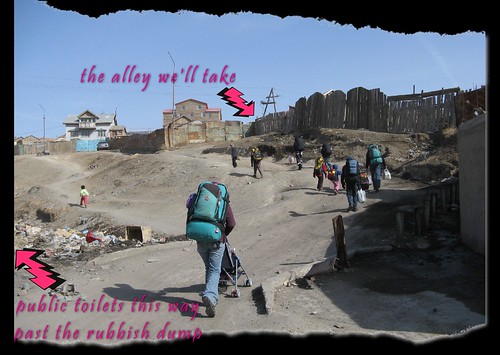
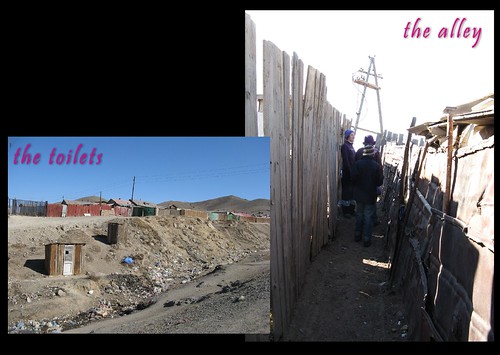
Out of the darkness of the fence-sided alley and into bright sunlight, we catch the first glimpse of where we are going to learn so much over the next two days.
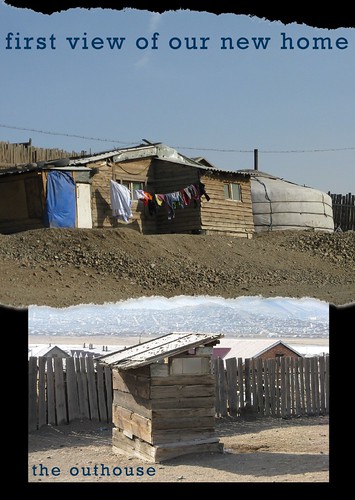
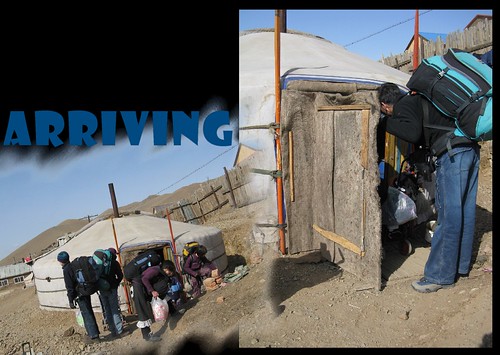
As I start to write, we are bursting with things to say, memories to capture, ideas to mull over. Our journals are a jumble of random thoughts, still in need of being processed. It was all so different.
Let’s start with 33-year-old Mungunsoymbo. Most strikingly, she smiles all the time, quietly hovering in the background getting on with the business of living and caring for her family. Like me, she bakes their daily bread and makes noodles by hand, using an identical pasta maker! Like me, she is concerned that plastic bags are littering the environment and has made her own reusable cloth bags for shopping. We both hang our family’s laundry on a line to dry. We both have countless uses for baking soda! As we work and talk together, we are always saying “Ah, me too. Same same. Exactly!”
But while there are similarities in our lives, it is clear to me that Soymbo’s is much harder. Every three days, whether under the scorching summer sun or sliding up snow and sheets of ice, she helps her husband haul 120 litres of water from the bore at the bottom of the hill. This water is carefully rationed. It needs to be boiled before being cooked with or drunk. It needs to be heated before being poured into the washbasin canister, which hangs on the splashback. When the undersink container is full, it needs to be emptied outside. This is your life when you don’t have running water or a sewerage system. And it makes her especially thankful for the fact that she has a washing machine for doing the laundry for her six family members – even if she does have to cart the machine from a building outside the ger into her home whenever she wants to use it.
She also has to keep a fire going all day. Not only does this require attention to the fire itself, but she also spreads out fresh cow dung to dry and then collects it up into sacks, one sack full a day. Cow dung, apart from burning cleanly and not polluting the environment like coal, and being cheap (in fact it’s free, unlike coal, which costs a bit and wood that is expensive), also burns less fiercely. The things ya learn eh!

Then there are some things that are just different. Maybe neither more difficult nor more simple. When I make the bed, it involves straightening some sheets on a frame and mattress and smoothing out a duvet. When Soymbo makes the bed, she bundles up the bedding used overnight and puts it on a shelf before folding up the felt mat on the floor. When I do the dishes there are plates and bowls and cutlery and glasses; a Mongolian family needs only to rinse out an already-licked bowl, one for each person. She has fewer dishes, I have running water. Bedtimes are different too. An early night for their family is 11pm, but the children sleep until 11 in the morning. Our children’s time clocks work about five hours earlier. Our host family graciously allows us an early (for them) night – that means everyone lies down to sleep at the same time and the lights are out by midnight. Exhausted, we sleep late for us – but 8am is early for them. By the end of the second day their children are falling asleep before dinner, tired out from their early morning. Ours are equally tired from their late nights! Different.
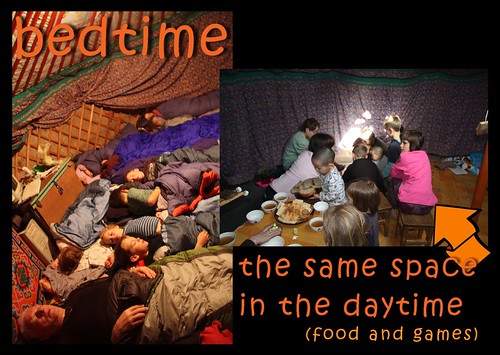
The late bedtime and sleeping arrangements (think sardines in a can), and the water restrictions are two of the answers that come when Rob asks everyone what stands out from this first ger experience. Other random answers follow:
- inside it was HOT (about 28 degrees most of the time during the day) even when it’s literally freezing outside
- they were always working – making food, cleaning the ger, feeding animals
- the toilets
Down the stony dusty hill about 50 metres away from the ger, is a small wooden structure with sloping roof. Even at its highest point it is too low to stand up in. But that’s OK, because the building is supposed to be squatted in anyway. When you’re as tall as Rob, you enter in a ready-for-action position! Two planks straddle a pit in which a brown offensive-smelling mountain is accumulating. By day it’s light enough to see the contents clearly. At night it is pitch black. Any time, day or night, the wind whistles around, chilling any exposed skin, especially when the mercury has dropped below zero! Ah yes, memorable experience that loo! - “There were lots of toys”
The perspective of a four-year-old, who has had next to no toys for six months, and who has obviously forgotten how much has been left at home. - they were always smiling, happy and contented, but simultaneously trying to change aspects of Mongolian culture (like pollution, debt, healthy living, maintaining good traditions, education, gardening, civic responsibility, manners – philosophically big dreamers, these guys!)
- the one-bowl-policy: everyone has one bowl. At the beginning of a meal it is filled with tea and everyone drinks. Then it is filled with salad or soup or whatever is on the menu. If you want another drink, you need to eat up first. Simple and effective.
- there was a closeness. Hard not to be when you have seventeen people in a circle with a diameter of no more than eight metres. A toddler flicks through a book, a few kids play chess or knucklebones, a few more are chopping apples for a “celebration salad” (apples, raisins and mayonnaise), someone sits off to one side drawing, two little girls are washing dishes in a bowl of water…..we are together.
And together we took in these new experiences. Together we noticed that it was surprisingly light – with the covering pulled back from the glass at the top of the tent, sunshine streamed in. Together we noticed it was also much more spacious than outside appearances suggest. Let me take you on a tour.
You’re standing at the front door, the inside of which is painted blue, red and yellow, the outside covered with a thick layer of felt, slightly larger than the door itself to keep any hint of draft away. The metal door handle has a piece of string attached – grab this when it’s really cold! When the door opens you’ll feel a blast of hot air and if you look down you’ll notice a 30cm high doorstep. Be sure to step over this, not on it.
You’ll find yourself on some cleaned-every-day, but always-dusty rough-sawn wooden boards. Stop here and take your boots off – pop them on the little wooden shelf to your left. Then take your first step on the wooden floor which is covered with a felt-backed vinyl – stop at the washbasin and wash your hands. Three times. In spring the temperature is warming up and bacteria are multiplying rapidly, hence our hosts’ fastidious insistence on handwashing (which we try to accomplish with a mere trickle of water – see above for why).

Now you can turn around. Reach up and dry your hands on the towel hanging on a washing line strung between red-painted roof supports, which branch out from a central roof circle (this is partitioned into eight sections, four of which are glass and can be covered in winter, the other four still covered now). As your hands rub together, you might keep looking up. Tucked in behind the roof supports you’ll spy a world map, a couchsurfing notebook, some brochures and newspapers, some toothbrushes and toothpaste, a saw and a rope.
If you let your eyes keep wandering leftwards from where you are standing, you’ll notice an almost-two-metre-long unit made from more roughsawn planks. You may be as surprised as we were to discover the bottom shelf houses an electric oven (use it between 11pm and 6am and it will cost you half as much as using it during the day). The middle shelf holds the massive bedding bundle. The top shelf offers protection from small family members for such treasures as a chess set, musical instruments and Todo’s “special shoe box”, which contains his precious possessions. Spare space in this unit is freely shared with couchsurfers! Then there’s a “couchsurfing corner” – a glass-fronted picture frame holds coins from around the world, the family’s couchsurfing guidelines are displayed (they have hosted 30 groups of people in ten months), and a Kiwi flag is now tucked into the roof supports too.
Coming further round the room is a beautiful brightly painted chest – orange with two shades each of purple, blue and green, all in geometric swirly design with black and white accents. Containing treasures, it is out of bounds to children! On top sits a television and carved wooden framed mirror. Right beside it, providing a space for a computer to rest, is another a cabinet, big enough for the little children to climb inside to find their toys! You will also find felted wool mats and a small wooden table with seven low wooden stools, which are moved around depending on what they are needed for. Apart from two plastic potties, two electric lights and the curtains which hang down the walls hiding the three layers of thick felt and the wooden criss-crossed wall framing, this almost completes the picture. All that remains is the kitchen, which is somewhat reminiscent of a Lao kitchen in its simplicity.
The centre of the room is dominated by the firebox with chimney pointing straight up through the glass roof. The cow dung container, a poker, metal water canisters, kettles and pots (a cross between pot, wok and cauldron) sit nearby. The large blue plastic water bucket stands just inside the door, to the right. Beside it is a container of root vegetables, ready for daily consumption. There is a cabinet and wooden crate for holding a small selection of food and a few dishes. A pocketed hanger suspended from the roof supports holds a wooden spoon, ladle, fish slice, sieve and grater. Wooden chopping boards, a pasta maker, scales, a thermos and 25kg sacks of flour and couscous are all that’s left for you to see.
Seeing this simplicity was one thing. Sitting around talking with the family was quite another matter. Our conversation was rich as we shared ideas about living. Thank you, Begzsuren and Mungunsoymbo, our first Mongolian friends, for a wonderful introduction to Mongolian life.
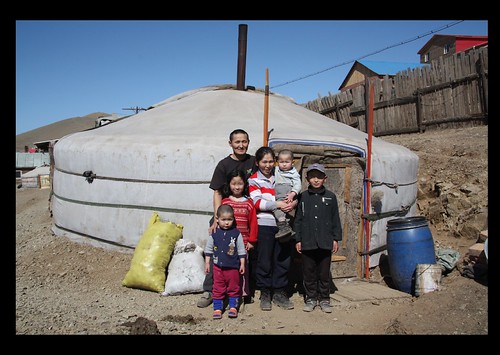
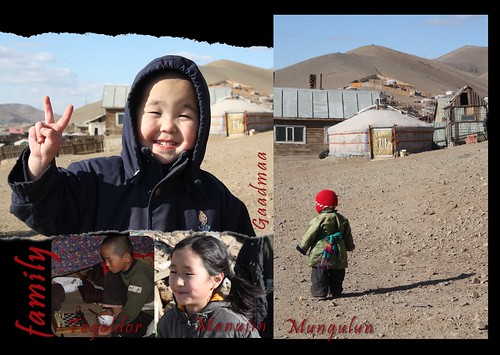
Tags: children, craft, food, health, housing, learning, parenting, postcard: Mongolia, toilet, tradition, transport, weather




Wow! What an experience. Thank you for sharing it in such a detailed manner (as you always do!)……so different…..to home….. and to what you have experienced so far.
I am amazed with that with the poverty and lack of infrastructure, that these people have access to internet (as I guess they must to be couchsurfer hosts). What a dichotomy.
AH yes – perhaps I should have made this explicit – the father of the family works at the UB library. In his lunchbreak he is allowed to use the computer to do couchsurfing business. Definietly no internet at home. Not even mobile phone coverage.